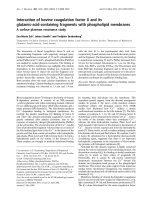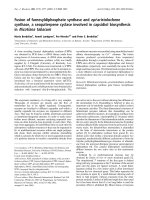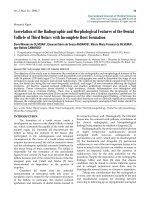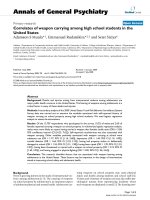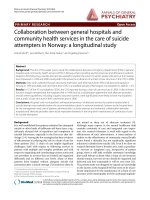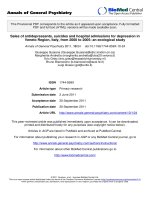Báo cáo y học: "Biomarkers of inflammation, coagulation and fibrinolysis predict mortality in acute lung injury" doc
Bạn đang xem bản rút gọn của tài liệu. Xem và tải ngay bản đầy đủ của tài liệu tại đây (487.75 KB, 8 trang )
Open Access
Available online />Page 1 of 8
(page number not for citation purposes)
Vol 12 No 2
Research
Biomarkers of inflammation, coagulation and fibrinolysis predict
mortality in acute lung injury
Dana McClintock
1
, Hanjing Zhuo
1
, Nancy Wickersham
2
, Michael A Matthay
1
and Lorraine B Ware
2
1
Cardiovascular Research Institute, 505 Parnassus Avenue, University of California, San Francisco, San Francisco, CA 94143, USA
2
Division of Allergy, Pulmonary and Critical Care Medicine, Department of Medicine, Vanderbilt University, T1218 MCN, 1161 21st Avenue S,
Nashville, TN 37232-2650 USA
Corresponding author: Lorraine B Ware,
Received: 17 Oct 2007 Revisions requested: 22 Nov 2007 Revisions received: 29 Jan 2008 Accepted: 21 Mar 2008 Published: 21 Mar 2008
Critical Care 2008, 12:R41 (doi:10.1186/cc6846)
This article is online at: />© 2008 McClintock et al.; licensee BioMed Central Ltd.
This is an open access article distributed under the terms of the Creative Commons Attribution License ( />),
which permits unrestricted use, distribution, and reproduction in any medium, provided the original work is properly cited.
Abstract
Background Acute lung injury (ALI) is a major cause of acute
respiratory failure with high mortality despite lung-protective
ventilation. Prior work has shown disordered inflammation and
coagulation in ALI, with strong correlations between biomarker
abnormalities and worse clinical outcomes. We measured
plasma markers of inflammation, coagulation and fibrinolysis
simultaneously to assess whether these markers remain
predictive in the era of lung-protective ventilation.
Methods Plasma samples and ventilator data were
prospectively collected from 50 patients with early ALI. Plasma
biomarkers of inflammation (IL-6, IL-8, intercellular adhesion
molecule 1), of coagulation (thrombomodulin, protein C) and of
fibrinolysis (plasminogen activator inhibitor 1) were measured by
ELISA. Biomarker levels were compared between survivors (n =
29) and non-survivors (n = 21) using Mann–Whitney analysis.
Results The tidal volume for the study group was 6.6 ± 1.1 ml/
kg predicted body weight and the plateau pressure was 25 ± 7
cmH
2
O (mean ± standard deviation), consistent with lung-
protective ventilation. All markers except IL-6 were significantly
different between survivors and nonsurvivors. Nonsurvivors had
more abnormal values. Three biomarkers – IL-8, intercellular
adhesion molecule 1 and protein C – remained significantly
different by multivariate analysis that included age, gender,
Simplified Acute Physiology Score II and all biomarkers that
were significant on bivariate analysis. Higher levels of IL-8 and
intercellular adhesion molecule 1 were independently predictive
of worse outcomes (odds ratio = 2.0 and 5.8, respectively; P =
0.04 for both). Lower levels of protein C were independently
associated with an increased risk of death (odds ratio = 0.5), a
result that nearly reached statistical significance (P = 0.06).
Conclusion Despite lung-protective ventilation, abnormalities in
plasma levels of markers of inflammation, coagulation and
fibrinolysis predict mortality in ALI patients, indicating more
severe activation of these biologic pathways in nonsurvivors.
Introduction
Acute lung injury (ALI) and acute respiratory distress syn-
drome (ARDS) are common causes of acute respiratory failure
with a high mortality rate despite decades of research into
these conditions [1]. Many studies have implicated activation
of inflammation and derangement of the coagulation and fibri-
nolytic pathways in patients with ALI/ARDS. A number of
biomarkers of inflammation are associated with poor clinical
outcomes in patients with ALI/ARDS, including intercellular
adhesion molecule 1 (ICAM-1), IL-6 and IL-8 [2-4]. In patients
with ALI/ARDS from a variety of predisposing conditions,
higher levels of the proinflammatory cytokines IL-6 and IL-8
predict worse outcomes [5]. Moreover, levels of ICAM-1
(unpublished data), IL-6 and IL-8 [5] and levels of other proin-
flammatory cytokines [6] are reduced by a low-tidal-volume
ventilatory strategy.
In addition to inflammatory markers, markers of dysregulated
coagulation and fibrinolysis are predictive of clinical outcomes
in patients with ALI/ARDS. Protein C is an endogenous anti-
coagulant and antiinflammatory protein that is activated by
binding to the thrombin–thrombomodulin complex on the
ALI = acute lung injury; ARDS = acute respiratory distress syndrome; ELISA = enzyme-linked immunosorbent assay; ICAM-1 = intercellular adhesion
molecule 1; IL = interleukin; PAI-1 = plasminogen activator inhibitor 1; PaO
2
/FiO
2
= ratio of arterial to inspired oxygen; SAPS II = Simplified Acute
Physiology Score II.
Critical Care Vol 12 No 2 McClintock et al.
Page 2 of 8
(page number not for citation purposes)
endothelium. Lower levels of protein C and higher levels of cir-
culating thrombomodulin are consistent with a procoagulant
state [7]. Fibrinolysis, the process of resolving clot formation,
is also impaired in patients with ALI/ARDS [8,9]. In a larger
multicenter study, higher levels of plasminogen activator inhib-
itor 1 (PAI-1) and lower levels of protein C in the plasma had
a synergistic association with higher mortality in patients with
ALI/ARDS [10]. Protein C levels increased in patients treated
with a low-tidal-volume ventilatory strategy in the study.
Given the importance of inflammation and coagulation to the
pathogenesis of ALI/ARDS and the demonstrated improve-
ment in biomarkers in these pathways in patients treated with
lower tidal volumes, we investigated whether biomarkers of a
proinflammatory, procoagulant and antifibrinolytic state remain
predictive in the era of routine use of low-tidal-volume ventila-
tion for ALI/ARDS. We chose to test multiple markers within
the inflammatory and coagulation cascades that have a care-
fully considered pathogenetic basis in ALI/ARDS. Our hypoth-
esis was that, despite effective institution of a lung-protective
ventilatory strategy, derangement in the plasma levels of
biomarkers reflecting inflammation and disordered coagula-
tion and fibrinolysis would be associated with increased mor-
tality in a cohort of prospectively collected patients with ALI/
ARDS.
Materials and methods
Subjects and patient samples
Fifty patients who met the American–European Consensus
Conference definition for ALI or ARDS [11] were recruited
from both Moffitt-Long University Hospital (33 patients) and
San Francisco General Hospital (17 patients) from 2003 to
2006. Patients were recruited for participation within 48 hours
of meeting the diagnostic criteria for ALI or ARDS. Informed
consent for study participation was obtained from each sub-
ject or their designated surrogate. In the case of surrogate
consent, follow-up consent was sought from the subject
whenever possible. The study was approved by the Commit-
tee on Human Research at the University of California San
Francisco and was performed in compliance with the man-
dates of the Helsinki Declaration.
Clinical data, including severity of illness scores and risk fac-
tors for the development of ALI/ARDS, were abstracted from
the medical record. Ventilator data were also recorded for
each subject at the time of collection of the plasma samples.
The tidal volume was expressed as the tidal volume per kilo-
gram of predicted body weight [12]. The primary outcome for
the present study was in hospital mortality. The University of
California San Francisco Committee on Human Research
approved the study protocol.
Plasma biomarker measurements
Plasma samples were collected from each patient at the time
of enrollment with the pre hoc intent to study biomarkers of
inflammation and coagulation. Blood was collected in heparin
tubes and centrifuged for 10 minutes at 3,000 × g. Plasma
supernatant was removed from the spun samples and was fro-
zen at -70°C until the time of analysis. The analyses included
markers of inflammation, coagulation and fibrinolysis. Specifi-
cally, we measured the inflammatory biomarkers ICAM-1, IL-6
and IL-8 and markers of disordered coagulation and fibrinoly-
sis, including protein C, thrombomodulin and PAI-1. An ELISA
was used to measure each biomarker in duplicate: ICAM-1, IL-
6 and IL-8 (R&D Systems, Minneapolis, MN, USA); thrombo-
modulin and PAI-1 (American Diagnostica, Stamford, CT,
USA); and Protein C (Helena Laboratories, Beaumont, TX,
USA).
Statistical analysis
All statistical analyses were performed using STATA software
(StataCorp, College Station, TX, USA). All analyses compared
survivors with nonsurvivors in this group of patients. For base-
line demographics and clinical data, we used chi-square anal-
ysis for dichotomous predictor variables and used an unpaired
t test to compare survivors and nonsurvivors.
Biomarker values were not normally distributed. Logarithmic
transformation of the biomarker data did not normalize the data
as assessed by the Shapiro–Wilk test of normalcy. Hence,
bivariate analysis of the association between biomarker values
and the outcome of mortality was assessed using nonparamet-
ric analysis, specifically Mann–Whitney analysis.
We subsequently performed a logistic regression analysis to
assess the contribution of demographic, clinical and biomar-
ker data to the outcome of mortality. We confirmed these find-
ings with a stepwise logistic regression model that included
sepsis as a condition predisposing to ALI/ARDS to determine
significant independent contributors to mortality in ALI/ARDS
patients. Sepsis was included in the model since sepsis alone
is recognized to contribute to increased mortality [1] as well as
to abnormalities in biomarker levels. Statistical significance for
each of these analyses was defined as P < 0.05.
Results
Demographic, clinical and ventilator parameters
Baseline demographic data and clinical variables are pre-
sented in Table 1. The ventilator parameters are presented in
Table 2. The ventilator parameters were similar to the ventilator
parameters reported for the 6 ml/kg tidal volume group in the
ARDS Network trial of lower tidal volume ventilation [12]. The
mean time between meeting diagnostic criteria for ALI/ARDS
and obtaining the day 1 plasma sample for this patient group
was 50 hours.
Comparison of demographic, clinical and ventilator
results by survival group
Survivors and nonsurvivors were similar in terms of age, gen-
der and racial distribution. There were more patients with
Available online />Page 3 of 8
(page number not for citation purposes)
sepsis in the group that did not survive (Table 3). Markers of
severity of disease, including the Acute Physiology and
Chronic Health Evaluation II score [13] and the Simplified
Acute Physiology Score II (SAPS II) [14], were higher in non-
survivors, although this finding only reached statistical signifi-
cance for the SAPS II score (P = 0.02). There were no
differences in the plateau pressure, the quasistatic respiratory
compliance, the PaO
2
/FIO
2
ratio or the oxygenation index
when comparing survivors with nonsurvivors (Table 3).
Biologic markers
Biomarker levels in survivors versus nonsurvivors are summa-
rized in Figures 1 and 2. All inflammatory biomarkers were ele-
vated in nonsurvivors compared with survivors. The elevations
were statistically significant, however, only in the cases of IL-8
and ICAM-1 (P = 0.002, P = 0.006 respectively; Figure 1).
Protein C levels were lower in patients that did not survive as
compared with patients that survived (P = 0.0003), a finding
that indicates greater consumption of this coagulation factor in
the group of patients that died (Figure 2a). More severe impair-
ment in coagulation in nonsurvivors was confirmed by evalua-
tion of thrombomodulin levels in this cohort of patients. Higher
thrombomodulin levels were demonstrated in patients who did
not survive compared with survivors (P = 0.005) (Figure 2b).
The PAI-1 levels were significantly higher in patients who died
compared with those in patients who survived (P = 0.01) (Fig-
ure 2c).
Multivariate analysis of clinical and biomarker results
A multivariate logistic regression analysis was performed to
evaluate multiple potential contributors to mortality in this
patient population. The predictor variables for this analysis
included clinical and demographic variables as well as biomar-
ker results. The demographic variables of age, gender and
SAPS II score were chosen because of their demonstrated
predictive value for outcomes in ALI [15,16]. The biologic
markers that were significantly different between groups on
bivariate analysis were also included. The final model therefore
included age, gender, SAPS II score, IL-8, ICAM-1, thrombo-
modulin, protein C and PAI-1. Biomarker data were logarithmi-
cally transformed prior to inclusion in the multivariate model,
given the abnormal distribution.
Elevations in IL-8 and ICAM-1 were independently predictive
of increased mortality in patients with ALI, even when consid-
ering age, gender, SAPS II score and other biologic marker
results (Table 4). Similarly, lower levels of protein C showed a
strong trend toward predicting worse clinical outcomes, inde-
pendent of other predictor variables (Table 4). Logistic regres-
sion analysis showed that, for each increase in the natural log
of IL-8, the risk of death doubled with an odds ratio of 2.0
(95% confidence interval = 1.1 to 4.0, P = 0.04). The risk of
death was even higher for ICAM-1. For each natural log
increase in the ICAM-1 level, the risk of death increased nearly
sixfold (odds ratio = 5.9, 95% confidence interval = 1.1 to 30,
P = 0.04). Finally, a strong trend was observed for protein C
levels, with lower levels associated with worse clinical out-
Table 1
Demographic and clinical data
Parameter Current study population value (n = 50)
Demographics
Age (years) (mean ± standard deviation) 55 ± 16
Gender (% male) 56
Race/Ethnicity
Asian (%) 14
African American (%) 16
Hispanic (%) 16
Caucasian (%) 54
Conditions predisposing to acute lung injury
Sepsis (%) 36
Pneumonia (%) 34
Aspiration of gastric content (%) 16
Transfusion of blood products (%) 4
Other
a
(%) 10
Hospital mortality (%) 42
a
Other group included pancreatitis, near drowning, smoke inhalation, drug overdose and post-surgical complication.
Critical Care Vol 12 No 2 McClintock et al.
Page 4 of 8
(page number not for citation purposes)
comes. The odds ratio for death decreased by one-half for
each natural log increase in the protein C levels (odds ratio =
0.5, 95% confidence interval = 0.2 to 1.0, P = 0.06).
To confirm these findings and to evaluate the role of sepsis as
a condition predisposing to ALI/ARDS, we carried out a step-
wise backward logistic regression for mortality. The analysis
included age, gender, SAPS II score, presence or absence of
sepsis and each of the biomarkers that showed significant dif-
ferences between groups in bivariate analyses: IL-8, ICAM-1,
protein C, PAI-1 and thrombomodulin. As above, we logarith-
mically transformed the biomarker variables to create a more
normalized distribution. To perform this analysis, we deter-
mined P values for all variables in the model and then sequen-
tially eliminated the variable with the highest P value, as long
as the P value was >0.20, until the p values for all remaining
variables in the model were P ≤ 0.20. Despite including sepsis
in the model, at the end of our analysis the only three variables
that remained were log IL-8, log protein, C and log ICAM-1.
Using this model, log IL-8 had an odds ratio of 1.6 (95%
confidence interval = 1.0 to 2.5, P = 0.03), log ICAM-1 had an
odds ratio of 2.8 (95% confidence interval = 0.9 to 9.3, P =
0.09) and, finally, log protein C had an odds ratio of 0.5 (95%
confidence interval = 0.3 to 1.1, P = 0.08).
Discussion
ALI is a complex illness with derangement in multiple meta-
bolic pathways, including inflammation, coagulation and fibri-
nolysis. Abnormalities of these pathways have been shown in
prior evaluations of patients with ALI/ARDS, with the greatest
abnormalities presenting in nonsurvivors. These results were
obtained, however, before the use of lower tidal volumes and
limitations in plateau pressures had been convincingly demon-
strated to decrease mortality in clinical ALI/ARDS [12]. Injuri-
ous high tidal volumes alone can cause derangements in
coagulation and fibrinolysis, and can trigger an inflammatory
response [17,18]. To assess abnormalities in inflammation,
coagulation and fibrinolysis independent of injurious ventila-
tion, we studied patients at two hospitals that routinely use a
low-tidal-volume plateau-pressure-limited ventilatory strategy
in patients with ALI/ARDS.
To our knowledge, this is the first study to demonstrate abnor-
malities in markers of inflammation and impaired coagulation
and fibrinolysis remain predictive of increased mortality
despite implementation of lung-protective ventilation.
Moreover, elevations in IL-8 and ICAM-1 were predictive of
increased mortality independent of important clinical predic-
tors and other biomarker abnormalities.
Our findings are consistent with earlier studies of biomarkers
in the era prior to routine use of lung-protective mechanical
ventilation. ICAM-1 is an adhesion molecule that facilitates
trafficking of neutrophils to the lung and is upregulated on the
lung endothelial surface during ALI/ARDS [2]. In patients with
ALI/ARDS, higher levels of soluble ICAM-1 in the pulmonary
edema fluid were associated with an increased length of
mechanical ventilation [3]. Higher plasma ICAM-1 levels were
also associated with mortality in a prospective study of chil-
dren with ALI/ARDS [4]. In patients with ALI/ARDS enrolled in
a multicenter study of a protective ventilatory strategy, higher
baseline levels of IL-6 and IL-8 were associated with increased
mortality [5].
Low levels of protein C showed a strong trend for being inde-
pendently predictive of worse outcome in ALI/ARDS. These
findings were confirmed in a rigorous stepwise backward
logistic regression model that included sepsis as a covariate.
This result is also consistent with prior work in ALI/ARDS. In a
small prospective cohort of patients with ALI/ARDS, lower lev-
els of protein C in pulmonary edema fluid were associated with
increased mortality [7], as were lower plasma levels in a larger
multicenter cohort [10] regardless of the presence or absence
of sepsis. We therefore believe that protein C is associated
with outcomes in ALI/ARDS and is not simply reflective of
higher numbers of patients with sepsis in the nonsurvivor
group. This finding suggests that protein C administration in
patients with ALI/ARDS may have some benefit; however, a
recent phase II, randomized controlled trial of activated protein
C administration in patients with ALI/ARDS was stopped early
because of lack of efficacy in the treatment group over pla-
cebo (Michael Matthay, unpublished data). Further work to
Table 2
Ventilator settings and physiologic parameters at enrollment
Parameter Current study population value
Number of patients 50
Tidal volume (per kg predicted body weight) 6.6 ± 1.1
Plateau pressure (cmH
2
O) 25 ± 7
PaO
2
/FIO
2
ratio 155 ± 72
Positive end expiratory pressure (cmH
2
O) 10 ± 4
Mean airway pressure (cmH
2
O) 17 ± 5
Available online />Page 5 of 8
(page number not for citation purposes)
understand the role of protein C in ALI/ARDS is therefore
indicated.
PAI-1 levels were significantly higher in nonsurvivors than sur-
vivors on bivariate analysis. This confirms previous work in ALI
examining PAI-1 levels in the era prior to routine use of low-
tidal-volume ventilation. Prior work has demonstrated
decreased urokinase activity in the air spaces of patients with
ALI/ARDS, and this decrease is explained by elevations in lev-
els of PAI-1 [8]. In a small single-center study, PAI-1 levels in
plasma and pulmonary edema samples from patients with ALI/
ARDS were associated with higher mortality rates [9]; this
finding was confirmed in a larger multicenter study [10]. In the
current study, the PAI-1 levels did not remain independently
predictive on multivariate analyses. This finding may reflect the
relatively small sample size.
Lung-protective ventilation, although clearly demonstrated to
improve survival in ALI/ARDS [12], has not been routinely
adopted as standard of care [19,20]. To confirm that patients
in our cohort were ventilated with a low-tidal-volume protocol,
we compared the ventilator settings for patients in our study
with data from the original ARDS Network trial of lower-tidal-
volume ventilation. The ventilator parameters were nearly iden-
tical for patients in our study compared with patients in the
original trial, with a mean tidal volume of 6.6 ml/kg predicted
body weight and a mean inspiratory plateau pressure of 25
cmH
2
O. One additional similarity between the current study
population and the ARDS Network trial population was that
the PaO
2
/FiO
2
ratio was lower (worse) in both cases in the
groups that survived, although the result was not statistically
significant. These data confirm that the PaO
2
/FiO
2
ratio is not
a good surrogate for outcomes in ALI.
Bivariate analysis of each of biomarker demonstrated that
higher levels of IL-8, ICAM-1, thrombomodulin and PAI-1 and
lower levels of protein C were significantly associated with
increased mortality. The higher levels of IL-8 and ICAM-1 sug-
gest there is greater upregulation of the acute inflammatory
process in patients with ALI/ARDS who did not survive their ill-
ness. Similarly, lower protein C and higher thrombomodulin
levels indicate greater activation of coagulation pathways in
patients who died. Finally, the significantly higher level of PAI-
1 in patients who died indicates greater impairment of fibrinol-
ysis in these patients. Given that these patients were main-
tained on lung-protective ventilation, ventilator-induced lung
injury is not a probable explanation for the abnormalities of
inflammation and coagulation.
Parsons and colleagues [5] demonstrated in ARDS Network
patients that low-tidal-volume ventilation was associated with
lower levels of plasma IL-6 and IL-8 levels by day 3 of the study
compared with patients maintained on 12 ml/kg. Protein C lev-
els were also normalized to a greater extent in the low-tidal-vol-
ume group [10]. A remaining possibility, however, is that even
a lung-protective ventilator strategy is injurious in the acutely
injured lung. In a rat model of acid-induced lung injury, Frank
and colleagues showed that lung endothelial and epithelial
injury were minimized by a reduction in tidal volume to 3 ml/kg
Table 3
Comparison of clinical and ventilator data by survival status
Parameter Survivors (n = 29) Nonsurvivors (n = 21) P value
a
Demographics
Age (years) (mean ± standard deviation) 55 ± 18 56 ± 14 0.76
Gender (% male) 55 57 0.89
Race (% Caucasian) 59 67 0.44
Sepsis as acute lung injury risk (%) 28 57 0.04
Clinical variables (mean ± standard deviation)
Simplified Acute Physiology Score II 42 ± 13 52 ± 13 0.02
Acute Physiology and Chronic Health Evaluation II 21 ± 6 24 ± 6 0.14
Lung injury score 2.9 ± 0.5 2.7 ± 0.6 0.32
Ventilator variables
Plateau pressure (cmH
2
O) 26 ± 8 24 ± 5 0.48
Quasistatic respiratory compliance (ml/cmH
2
O) 32 ± 10 30 ± 11 0.60
PaO
2
/FiO
2
ratio 150 ± 65 162 ± 82 0.54
Oxygenation index 14 ± 10 12 ± 8 0.50
a
Comparisons were made using chi-square analysis for dichotomous predictor variables and using an unpaired t test for continuous predictor
variables.
Critical Care Vol 12 No 2 McClintock et al.
Page 6 of 8
(page number not for citation purposes)
compared with 6 or 12 ml/kg [17], suggesting that even a 6
ml/kg tidal volume might be injurious in some patients.
There are some limitations to our study. First, we studied a rel-
atively small cohort of patients from two hospitals. For this rea-
Figure 1
Biomarkers of inflammation in acute lung injury and acute respiratory distress syndromeBiomarkers of inflammation in acute lung injury and acute respiratory
distress syndrome. Comparison of plasma levels of biomarkers of
inflammation in 50 patients with acute lung injury and acute respiratory
distress syndrome ventilated with low-tidal-volume ventilation. Plasma
levels of (a) IL-8 and (b) soluble intercellular adhesion molecule 1
(sICAM-1) were significantly higher in nonsurvivors than in survivors.
Data shown as boxplots: horizontal line, median; box, 25th to 75th per-
centiles; error bars, 10th to 90th percentiles. *P = 0.002 and **P =
0.006 compared with survivors, Mann–Whitney U test.
Figure 2
Biomarkers of disordered coagulation and fibrinolysis in acute lung injury and acute respiratory distress syndromeBiomarkers of disordered coagulation and fibrinolysis in acute lung
injury and acute respiratory distress syndrome. Comparison of plasma
levels of biomarkers of disordered coagulation and fibrinolysis in 50
patients with acute lung injury and acute respiratory distress syndrome
ventilated with low-tidal-volume ventilation. (a) Plasma levels of protein
C were significantly lower in nonsurvivors compared with survivors. (b)
Plasma levels of thrombomodulin were significantly higher in nonsurvi-
vors compared with survivors. (c) Plasma levels of plasminogen activa-
tor inhibitor 1 (PAI-1) were significantly higher in nonsurvivors
compared with survivors. Data shown as boxplots: horizontal line,
median; box, 25th to 75th percentiles; error bars, 10th to 90th percen-
tiles. *P = 0.0003, **P = 0.005 and
§
P = 0.01 compared with survi-
vors, Mann–Whitney U test.
Available online />Page 7 of 8
(page number not for citation purposes)
son, the study may have been underpowered to show a
significant association between lower levels of protein C and
adverse clinical outcomes in the multivariable analyses. Sec-
ond, data were not collected on the ventilatory strategy
employed prior to enrolment in the study. Patients were
enrolled within 48 hours of meeting diagnostic criteria for ALI/
ARDS so there was a maximum of 2 days in which patients
may have received injurious ventilation. We therefore cannot
rule out injurious ventilation prior to enrolment in the study pos-
sibly contributing to the findings of the study. Third, the
biomarkers we studied were logarithmically transformed to
enable statistical analysis. In practice, this means that a large
increase in a biomarker such as IL-8 level is associated with a
somewhat smaller increased risk of death. The results from the
present study are therefore more likely to be useful in under-
standing the pathogenesis and ongoing injury during ALI/
ARDS than as a diagnostic test for individual patients with ALI/
ARDS.
In summary, the association of the biologic markers with
adverse clinical outcomes does not confirm causality, but
rather suggests important in vivo pathways for further study. In
addition to clinical utility for prognostication and stratification
of patients for enrollment in clinical trials, the clinical measure-
ment of biomarkers may help to elucidate mechanisms of
human disease that may have value in designing new therapies
for ALI/ARDS.
Conclusion
Plasma biomarkers that are related to inflammation and
enhanced neutrophil recruitment to the lung are independently
associated with increased mortality in patients with ALI. The
borderline significant association of lower protein C levels with
nonsurvivors continues to support the role for disordered
coagulation in ALI/ARDS. These associations exist despite
consistent use of lung-protective ventilation and persist even
when controlling for clinical factors that also impact upon out-
comes. The two biomarkers with an independent association
with mortality, IL-8 and ICAM-1, should be studied further for
their potential value in stratifying patients in clinical trials.
Competing interests
The authors declare that they have no competing interests.
Authors' contributions
DM conceived the study, enrolled the patients, collected the
samples, interpreted the data and drafted the manuscript. HJZ
assisted with the biostatistical analysis. NW carried out the
immunoassays. MAM and LBW conceived the study, partici-
pated in its design and coordination and helped to draft the
manuscript. All authors read and approved the final
manuscript.
References
1. Rubenfeld GD, Caldwell E, Peabody E, Weaver J, Martin DP, Neff
M, Stern EJ, Hudson LD: Incidence and outcomes of acute lung
injury. N Engl J Med 2005, 353:1685-1693.
2. Moss MD, Gillespie MK, Ackerson L, Moore FA, Moore EE, Par-
sons PE: Endothelial cell activity varies in patients at risk for
the adult respiratory distress syndrome. Crit Care Med 1996,
24:1782-1786.
3. Conner ER, Ware LB, Modin G, Matthay MA: Elevated pulmonary
edema fluid concentrations of soluble intercellular adhesion
molecule-1. Biological and clinical significance. Chest 1999,
116:83S-84S.
4. Flori HR, Ware LB, Glidden D, Matthay MA: Early elevation of
plasma soluble intercellular adhesion molecule-1 in pediatric
acute lung injury identifies patients at increased risk of death
and prolonged mechanical ventilation. Pediatr Crit Care Med
2003, 4:315-321.
5. Parsons PE, Eisner MD, Thompson BT, Matthay MA, Ancukiewicz
M, Bernard GR, Wheeler AP: Lower tidal volume ventilation and
plasma cytokine markers of inflammation in patients with
acute lung injury. Crit Care Med 2005, 33:1-6.
6. Ranieri VM, Suter PM, Tortorella C, De Tullio R, Dayer JM, Brienza
A, Bruno F, Slutsky AS: Effect of mechanical ventilation on
inflammatory mediators in patients with acute respiratory dis-
tress syndrome. JAMA 1999, 282:54-61.
Table 4
Multivariate logistic regression for clinical and biologic predictors of mortality
a
Predictor variable Odds ratio for mortality (per natural log increase in biomarker level) 95% confidence interval P value
IL-8 2.0 1.1 to 4.0 0.04
Intercellular adhesion molecule 1 5.8 1.1 to 30 0.04
Protein C 0.5 0.2 to 1.0 0.06
a
Multivariate model included age, gender, Simplified Acute Physiology Score II score, log IL-8, log intercellular adhesion molecule 1, log
thrombomodulin, log protein C and log plasminogen activator inhibitor 1 to predict the outcome of mortality. Predictor variables not presented in
the table showed P > 0.3.
Key messages
• In a group of ARDS patients treated with strict low-tidal-
volume ventilation, plasma biomarkers that are related to
inflammation (IL-8) and to enhanced neutrophil recruit-
ment to the lung (ICAM-1) are independently associ-
ated with increased mortality in patients with ALI.
• The trend towards independent association of lower
protein C levels with nonsurvivors supports the role for
disordered coagulation in ALI/ARDS.
• Despite lung-protective ventilation, abnormalities in
plasma levels of markers of inflammation, coagulation
and fibrinolysis predict mortality in ALI/ARDS patients,
indicating more severe activation of these biologic path-
ways in nonsurvivors.
Critical Care Vol 12 No 2 McClintock et al.
Page 8 of 8
(page number not for citation purposes)
7. Ware LB, Fang X, Matthay MA: Protein C and thrombomodulin
in human acute lung injury. Am J Physiol Lung Cell Mol Physiol
2003, 285:L514-L521.
8. Bertozzi P, Astedt B, Zenzius L, Lynch K, LeMaire F, Zapol W,
Chapman H: Depressed bronchoalveolar urokinase activity in
patients with adult respiratory distress syndrome. N Engl J
Med 1990, 322:890-897.
9. Prabhakaran P, Ware L, White K, Cross M, Matthay M, Olman M:
Elevated levels of plasminogen activator inhibitor-1 in pulmo-
nary edema fluid are associated with mortality in acute lung
injury. Am J Physiol Lung Cell Mol Physiol 2003, 285:L20-L28.
10. Ware LB, Matthay MA, Parsons PE, Thompson BT, Januzzi JL, Eis-
ner MD, The National Heart Lung and Blood Institute's ARDS Clin-
ical Trials Network: Pathogenetic and prognostic significance of
altered coagulation and fibrinolysis in acute lung injury/acute
respiratory distress syndrome. Crit Care Med 2007,
35:1821-1828.
11. Bernard GR, Artigas A, Brigham KL, Carlet J, Falke K, Hudson L,
Lamy M, Legall JR, Morris A, Spragg R: The American–European
Consensus Conference on ARDS. Definitions, mechanisms,
relevant outcomes, and clinical trial coordination. Am J Respir
Crit Care Med 1994, 149:818-824.
12. Acute Respiratory Distress Syndrome Network: Ventilation with
lower tidal volumes as compared with traditional tidal volumes
for acute lung injury and the acute respiratory distress
syndrome. N Engl J Med 2000, 342:1301-1308.
13. Knaus WA, Draper EA, Wagner DP, Zimmerman JE: APACHE II: a
severity of disease classification system. Crit Care Med 1985,
13:818-829.
14. LeGall J, Lemshow S, Saulnier F: A new Simplified Acute Physi-
ology Score (SAPS II) based on a European/North American
multicenter study. JAMA 1993, 270:2957-2963.
15. Nuckton TJ, Alonso JA, Kallet RH, Daniel BM, Pittet J-F, Eisner MD,
Matthay MA: Pulmonary dead-space fraction as a risk factor for
death in the acute respiratory distress syndrome. N Engl J
Med 2002, 346:1281-1286.
16. Ware LB: Prognostic determinants of acute respiratory dis-
tress syndrome in adults: impact on clinical trial design. Crit
Care Med 2005,
33(3 Suppl):S217-S222.
17. Frank J, Gutierrez J, Jones K, Allen L, Dobbs L, Matthay M: Low
tidal volume reduces epithelial and endothelial injury in acid-
injured rat lungs. Am J Respir Crit Care Med 2002,
165:242-249.
18. Choi G, Wolthuis EK, Bresser P, Levi M, van der Poll T, Dzoljic M,
Vroom MB, Schultz MJ: Mechanical ventilation with lower tidal
volumes and positive end-expiratory pressure prevents alveo-
lar coagulation in patients without lung injury. Anesthesiology
2006, 105:689-695.
19. Weinert CR, Gross CR, Marinelli WA: Impact of randomized trial
results on acute lung injury ventilator therapy in teaching
hospitals. Am J Respir Crit Care Med 2003, 167:1304-1309.
20. Brun-Buisson C, Minelli C, Bertolini G, Brazzi L, Pimentel J,
Lewandowski K, Bion J, Romand J-A, Villar J, Thorsteinsson A,
Damas P, Armaganidis A, Lemaire F, ALIVE Study Group: Epide-
miology and outcome of acute lung injury in European inten-
sive care units. Intensive Care Med 2004, 30:51-61.



